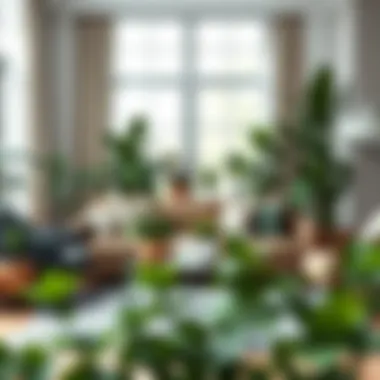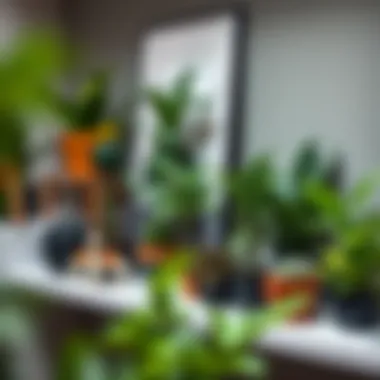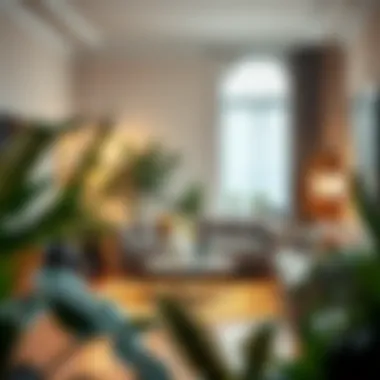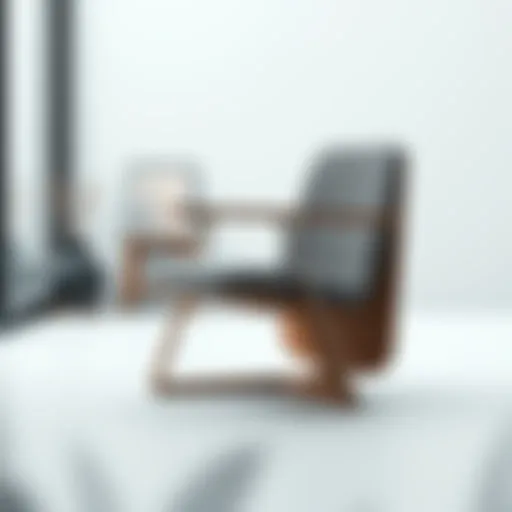Exploring the Benefits of Faux Plants in Design


Intro
In the realm of interior design, faux plants have emerged as a compelling alternative to their living counterparts. The allure lies not only in their aesthetic appeal but also in their practicality for homeowners and decorators alike. Unlike real plants, faux variants don't need watering, sunlight, or even a hint of green thumb. This aspect makes them a go-to choice for many who live busy lives or have less-than-ideal growing conditions in their homes.
The Rise of Faux Plants
The trend towards faux greenery has witnessed a significant boost recently, driven by a desire for spaces that reflect personal style without the associated upkeep. As the struggle between aesthetics and practicality continues, many seek to strike a balance. Faux plants, especially, allow individuals to bring the outside in, enhancing living spaces with vibrant color and texture without the time commitment involved in caring for real plants.
This article aims to explore this burgeoning interest in faux plants. We will look at how they fit into various design styles, the particular types available, and how to maintain them to ensure their longevity. By the end, readers should have a well-rounded understanding of how to incorporate faux plants into their decor strategy, while aligning with modern trends.
Furniture Styles and Trends
Understanding where faux plants fit within the broader context of furniture styles and trends can enhance their appeal. The choice of faux greenery can either contrast or complement existing decor, making it crucial to grasp the nuances in various aesthetics.
Modern vs. Traditional: Understanding the Aesthetics
Modern interiors lean towards minimalism, often featuring sharp lines, neutral colors, and an emphasis on function. Faux plants in these spaces can act as striking focal points— consider a tall, slender snake plant or a simplistic cactus placed strategically in a corner.
On the other hand, traditional styles favor warmth and rich textures. Here, leafy ferns or lush flowering plants like hibiscus faux variants can harmoniously blend with wood furniture and ornate details, offering a contrast that feels inviting and nostalgic.
Color and Material Trends: What's In and What's Out
Current trends highlight a shift towards earthy tones and natural materials. This includes a growing popularity for faux plants crafted from materials mimicking real foliage, such as silk for leaves or resin for stems. Embracing hues found in nature—soft greens, rust browns, and muted beiges—captures that organic feel. When selecting faux plants, look for those that not only mimic these colors but texture as well.
"Faux plants can transform a bland corner into a vibrant nook, providing both style and serenity."
Choosing the Right Faux Plants
When it comes to choosing faux plants that will enhance your specific space, consider several factors. Think about the amount of natural light in the room, the color palette, and your personal design style. Here are some thoughts worth considering:
- Scale and Size: Measure your space before buying. A massive faux tree might overwhelm a small room, while a petite succulent may get lost in grand decor.
- Place Them Wisely: Choose spots where they will benefit from natural falls of light, even if it’s just ambient. This adds to the illusion of real plants.
- Play with Varieties: Mixing different types of faux plants can create a more dynamic and lively space.
Care and Maintenance of Faux Plants
While faux plants require far less care than living plants, they still benefit from some upkeep. Here are simple maintenance tips to keep them looking fresh:
- Dust Regularly: Faux plants collect dust. Wipe leaves gently with a damp cloth every so often.
- Avoid Direct Sunlight: Too much sunlight can fade colors; this can make your faux plants look less vibrant over time.
- Store Seasonal Variants: If you have seasonal faux plants, consider storing them away in between holidays for a clean look.
Overall, faux plants bridge the gap between nature and the indoors, allowing for flexibility in design choices. In the journey through this article, we will explore deeper nuances, styles, and trends associated with faux plants. From selection tips to feature plants that resonate with various styles, the course is set for a thorough examination of what faux plants can do to enhance our spaces.
Understanding Faux Plants
Faux plants have carved a niche in modern interior design, offering a blend of beauty without the fuss often associated with living flora. Understanding the essence of faux plants is paramount for anyone looking to enhance their space. This section tackles the elements you should know, the benefits, and various considerations that come with choosing faux options.
Definition and Composition
At the heart of it, faux plants are artificial replicas of real plants crafted from a variety of materials such as plastic, silk, and even high-grade polymers. They are designed to imitate the look and feel of natural plants, often so well that many can’t tell the difference at first glance. These imitation greens include everything from delicate blossoms to towering trees, all made to withstand the test of time. The quality can vary widely—some pieces imitate real plants more closely than others—so discerning buyers often find themselves comparing details such as leaf texture and color precision. For a homeowner or a design aficionado, selecting high-quality faux plants can mean the difference between an eye-catching decoration and a lifeless prop.
Historical Context
Faux plants aren't just a recent phenomenon; their roots stretch back to the early days when artisans sought to preserve the beauty of nature without the associated challenges of maintaining live specimens. In the 20th century, particularly during the 1950s, synthetic materials began to be used more broadly in home decor, marking a turning point. With the evolution of design technologies, manufacturers have refined their crafting methods to create highly realistic representations of plants that capture the nuances of nature. The rise of environmental awareness has further propelled faux plants into the spotlight—offering an eco-friendly alternative to traditional horticulture while making it easier for city dwellers to incorporate greenery into their homes. The fusion of utility and aesthetics makes faux plants a compelling choice for those navigating modern life’s demands.
Benefits of Faux Plants
Faux plants have carved out a niche in home decor and design. Many homeowners and designers are drawn to them for a multitude of reasons. Their practicality, aesthetic appeal, and adaptability to different environments make them a valuable asset in the quest for greener, more vibrant living spaces. By exploring the benefits of faux plants, one can gain a holistic perspective on how they enhance our interiors while addressing various practical concerns.
Longevity and Durability
Faux plants are, by nature, designed to last. Unlike natural plants, which may wilt and decay, these artificial counterparts maintain their appearance year after year. The materials used in crafting faux plants, such as high-quality plastics and fabrics, are engineered for longevity. This means that once you’ve made an investment in a decent faux plant, you aren't just buying a momentary aesthetic enhancement; you’re investing in a long-term decor element.
Moreover, faux plants are resilient against the elements. They won’t dry out in low light or get too much sun. After all, who hasn't seen a beloved houseplant perish because it got too much love or too little water? This durability allows for greater flexibility in how and where these plants can be displayed.


Maintenance and Care
One of the greatest appeals of faux plants is their low-maintenance nature. Unlike live plants that demand attention—be it watering, feeding, or pruning—faux plants simply require an occasional dusting. A microfiber cloth and a spritz of water or a gentle cleaning spray are typically all that’s needed to keep them looking fresh. This simplicity is particularly attractive for individuals with busy lifestyles or those who may not have a green thumb.
Another advantage is that faux plants are often versatile in their placement. They can neatly adorn coffee tables, brighten up corners, or serve as focal points in dining rooms without the risk of overwatering, wilting, or pest infestations. This freedom allows homeowners to experiment with designs and arrangements more freely.
Allergen-Free Living
For those who suffer from allergies, faux plants offer a refreshing alternative to their living counterparts. They do not produce pollen or other allergens that can contribute to respiratory issues or discomfort. This makes them particularly appealing in households where allergy sufferers reside, as well as in commercial spaces like offices and eateries where air quality can be a concern.
The absence of allergens means that faux plants can be enjoyed without worry, allowing everyone to appreciate greenery in their environment. This aspect has become especially relevant in today’s context, where health and wellness are at the forefront of many people’s minds.
Types of Faux Plants
Understanding the various types of faux plants available is crucial for anyone looking to enhance their living space with artificial greenery. Each type serves a distinct purpose and can contribute to the overall aesthetic of a home. They offer flexibility in design while eliminating many of the challenges associated with real plants, such as maintenance and environmental requirements. The advantages of faux plants extend beyond convenience; they cater to diverse design sensibilities and environments.
Faux Flowers
Faux flowers are among the most popular choices for adding a splash of color and vibrancy to your home decor. These artificial blooms come in various styles, from whimsical daisies to elegant orchids. One key benefit of faux flowers is that they provide year-round beauty without the need for watering or sunlight. They are also excellent for individuals with allergies, as they don't shed pollen.
When selecting faux flowers, consider their realistic appearance. Higher-quality options often have detailed texture and vibrant color gradients, making them look more like the real thing. They can be arranged in beautiful bouquets, placed in vases, or served as a centerpiece on the dining table. Customization is another strong suit of faux flowers, allowing homeowners to mix and match various types for a personalized touch.
Faux Trees
Faux trees deliver a grand presence in any room, offering the same lush appeal as live trees but without the fuss. Popular choices include fiddle leaf figs and rubber plants, which have become staples in modern decor. This category of faux plants can easily fill large spaces, making them ideal for offices or expansive living rooms.
One major consideration when choosing faux trees is their scale. Make sure to assess the height and width to match your interior space. The right faux tree can act as a focal point, drawing the eye and adding depth to an otherwise flat area. While selecting, pay attention to details such as branching patterns and leaf textures, as these elements significantly contribute to the tree's overall realism.
Faux Succulents and Cacti
Faux succulents and cacti have carved out a reputation for their low-profile yet impactful presence. These plants are particularly appealing for minimalist designs and can bring a touch of the desert into your home. Crafted with precision, these faux plants often mimic the unique shapes and colors of natural succulents, creating intrigue and a modern aesthetic.
A key advantage of opting for faux succulents is their minimal maintenance. Unlike their real counterparts, they won't wither or drop leaves. This means you can place them in hard-to-reach spots or in areas where natural sunlight is scarce. When incorporating faux succulents, consider using textured pots for added dimension and style.
Faux Greenery and Ferns
Faux greenery and ferns offer a lush backdrop and can imbue a space with a sense of tranquility. Soft ferns, trailing vines, and dense foliage can fill nooks and crannies, softening sharp architectural lines. These pieces work well in both indoor and outdoor settings, allowing you to create a verdant oasis on your porch or balcony.
When choosing faux greenery, think about layering different heights and types to achieve depth and visual interest. Mix in headers and draping plants for a more organic look. The versatility of faux greenery means that it can cater to various decor styles, be it coastal, traditional, or contemporary.
“In the right arrangement, faux greenery is not just a decor element; it becomes an integral part of your design narrative.”
In summary, the types of faux plants available can greatly influence your interior design choices and overall aesthetic. With careful consideration of style, space, and personal preference, anyone can find the perfect artificial greenery that fits their home.
Choosing the Right Faux Plants
Selecting the right faux plants is crucial for creating an effective and inviting atmosphere in your home. Unlike a real plant that could thrive or wither based on care, faux plants offer flexibility without the same demands. However, making a wrong choice still results in a subpar aesthetic. Here, we explore essential elements to consider, ensuring your selection complements your space.
Assessing Space and Environment
Before diving into faux plants, step back and evaluate the space you have. Think about the dimensions, lighting, and overall style of your room. If you're working with tight corners or smaller areas, opt for slim designs, such as faux ferns or cacti, that maximize space without overwhelming it. On the other hand, a larger area can gracefully accommodate faux trees, creating vertical interest and a sense of openness.
Additionally, consider the lighting conditions. Some faux plants mimic species that grow in low light, while others may echo plants found in bright, sunlit environments. By aligning the faux plant type with your room’s natural light, you enhance the believability of your decor.
Color and Aesthetic Considerations
Color is more than just a hue; it’s an emotional touchstone for any space. When choosing faux plants, it’s vital to think about how their colors interact with your existing decor. Are your walls warm-toned and cozy? Consider earthy greens that blend seamlessly with your palette. Alternatively, cooler storage styles might benefit from vibrant pops of color that stand out, like the bright flowers of faux orchids.
Patterns and textures add depth to any arrangement. Mixing various faux plants creates a richer visual effect, especially when combining smooth and textured leaves. Think about how different textures can create dynamic contrasts.
"Using faux plants can completely transform the vibe of a room, just like choosing the right paint color or piece of furniture."
Quality vs. Price


It's essential to balance quality and price when selecting faux plants. While affordable options may be tempting, investing in higher-quality items often pays off in the long run. Cheaper plants can appear overly shiny or artificial, which can undermine your decor's authenticity. Conversely, a quality faux plant provides realistic details, like individual leaf veins or silk blooms, enhancing the overall look.
When evaluating quality, pay close attention to the craftsmanship. For instance, look for polyester blends that mimic real foliage well. Another indicator of quality is the weight of the plant; heavier pieces often indicate greater durability and sturdiness.
In terms of price, consider your budget. Faux plants come with a range of costs; thus, it's wise to do some homework. Sites like Wikipedia or Consumer Reports often have useful reviews on brand quality across different price points. Investing in a few high-quality pieces can often be better than purchasing multiple lower-quality ones.
Ultimately, aligning your choice with your space, desired aesthetic, and budget will help make your faux plant experience both stylish and satisfying.
Innovations in Faux Plant Design
As faux plants continue to gain traction in interior design, innovations in their design have turned heads and raised standards. No longer are these artificial greens relegated to the realm of garish decorations; they now embody realism and practical functionality that align with modern lifestyle demands. This section explores the nuances of contemporary faux plant design, emphasizing the significance of realistic textures and the rise of smart technology in these faux greens.
Realistic Textures and Finishes
The development of realistic textures and finishes in faux plants has fundamentally changed how these items are perceived. Manufacturers are investing in advanced materials that emulate the delicate veins of leaves, the soft touch of petals, and the varied tones of bark.
- Advanced Material Use: Materials like high-quality silk, polyethylene, and even recycled plastics are engineered to mimic the organic properties of natural plants. This careful attention to detail brings depth and life to each piece.
- Variety in Finishes: From matte to glossy, faux plants come with finishes that can suit any decor style. For instance, a glossy finish might enhance a contemporary setting while a matte look could complement a rustic theme.
"Today's faux plants are about not just looking good but feeling real. With meticulous crafting, they can almost trick the eye and might even prompt a second glance!"
Moreover, the craftsmanship involved in these designs has improved significantly. Techniques like hand-painting and fine-tuning details help create not just imitation but flattering representations of live foliage.
Smart Faux Plants
With the rapid evolution of technology, it is unsurprising that faux plants are now getting a tech upgrade. Smart faux plants are carving out a niche where interior decor meets functionality—making them not just pretty, but clever.
- Integration with Smart Homes: Many new faux plants come equipped with sensors that can monitor and indicate ambient conditions such as humidity and light levels, enhancing the home environment. Some even include light features, illuminating a space softly and adding a dynamic visual element.
- Ease of Connectivity: Many smart faux plants can connect with home automation systems like those of Amazon Alexa or Google Home, allowing homeowners to manage their decor through voice commands.
These innovations signify the next frontier in faux plant design—melding style with utility. It reflects a broader trend where aesthetic sensibility and the practicality of modern living come together, providing not just decorative elements, but contributing positively to the quality of life at home.
Faux Plants in Interior Design
Faux plants have evolved significantly in the realm of interior design. They offer attributes that real plants struggle to match, making them a preferred choice for many homeowners, decorators, and DIY enthusiasts. Faux plants are incredibly versatile, enhancing various design styles while providing a splash of greenery to indoor spaces without the hassle of maintenance.
Complementing Different Styles
The beauty of faux plants is their ability to adapt to various design aesthetics. Whether your space is modern, traditional, or a bohemian wonderland, there’s a faux plant that will beautifully fit right in.
Modern Aesthetic
In modern interiors, minimalism reigns supreme. The hallmark characteristic of this style is simplicity paired with clean lines and a clutter-free environment. Faux plants, such as sleek, sculptural succulents or tall, elegant spiky cacti, contribute positively to this atmosphere. They provide an organic touch without overwhelming the design.
A key aspect of integrating faux plants in a modern aesthetic is their low maintenance. You don’t have to worry about watering schedules or sunlight requirements. Instead, you can focus on the visual appeal, using plants like the Fiddle Leaf Fig or Snake Plant to create striking echoes of nature inside. Their presence in a room can serve as a conversation starter, marrying the natural with the contemporary.
Traditional Elegance
Under the banner of traditional elegance, you find warmth and a sense of history. Key characteristics of this approach include ornate furniture, rich color palettes, and intricate details. Faux plants like Boxwood Topiaries or Rosemary Plants bring the lushness of a garden into the traditional home without the burdens of upkeep.
A unique feature of traditional spaces is their story. Faux plants can enhance that narrative. They introduce life to a room while complementing timeless design elements like crown moldings and wooden mantles. However, one must tread carefully; poorly made faux plants can clash with the elegance, emphasizing the need for quality.
Bohemian Touch
The Bohemian style is known for being eclectic and carefree, reflecting a certain artistic free spirit. It embraces a range of colors, textures, and patterns, allowing for freedom in design choices. Faux plants like oversized Monstera leaves or vibrant Hibiscus blooms can elevate the casual yet royal look often found in bohemian interiors.
A key characteristic of this style is the celebration of nature's untamed beauty. Faux plants serve as an anchor, helping to create a more cohesive look while retaining the energy of the design. The charm of using faux plants is that they allow for creativity without the constraints associated with live plants, such as seasonal changes or environmental conditions.
Functionality in Space
Beyond aesthetic considerations, faux plants also offer functionality in various spaces. They can improve air quality, create focal points, or fill empty areas without the constraints a real plant would impose. For instance, a generously sized faux tree can fill a corner back there that feels too empty.
In workspaces, small faux plants on desks improve productivity by adding an element of comfort without the distraction of real plants needing care. Altogether, faux plants blend seamlessly into the environment, making the most of any design scheme.
"Faux plants, when well chosen, can be every bit as expressive as their living counterparts."


In summary, faux plants significantly enhance interior design by complementing styles from modern minimalism through traditional elegance to a bohemian touch while also offering functional benefits. Their versatility, ability to adapt, and the lack of maintenance they require make them an invaluable asset in contemporary homes. Incorporating them into your design scheme can not just add beauty but also serve practical purposes, lending warmth and character to your space.
Sustainability and Faux Plants
With growing awareness about environmental issues, the discussion around sustainability has become paramount across all industries—including home decor. In this context, the choice between natural and synthetic materials is becoming more scrutinized. Faux plants are not just decorative pieces but can also play a role in sustainable living. Understanding how sustainability intertwines with faux plants gives homeowners, designers, and DIY enthusiasts much to ponder.
Environmental Impact
Faux plants typically made from materials like PVC and polyester have come under fire for their ecological footprint. Unlike their live counterparts, they don’t require water and sunlight, which is a plus in areas suffering from water scarcity. However, the production process, which often involves chemicals and non-biodegradable plastics, can negatively impact the environment. When considering faux plants, it's crucial to look at:
- Longevity: Faux plants last for years, reducing the need for frequent replacements that often come with live plants.
- Waste Production: While they don’t decompose easily in landfills, their long lifespan mitigates the frequency at which they are discarded.
- Transportation: The environmental cost of transporting faux plants, particularly those crafted in foreign countries, can contribute to carbon emissions. Thus opting for local artisans or brands can lessen this burden.
"The right faux plants can enhance your decor without draining the earth's resources."
Sustainability doesn’t always mean opting for all-natural decor. When carefully chosen, faux plants can coexist with eco-friendly practices. Think of them as a complement to your living space while helping to reduce the consumption of live flora.
Ethical Sourcing of Materials
As awareness grows, so does the demand for ethical sourcing practices in the manufacture of faux plants. Consumers are increasingly keen on knowing where their products come from and how they are made. This shift has led to brands focusing on transparency and sustainability throughout their supply chains. Consider these elements when evaluating faux plants:
- Materials Used: Look for brands that use recycled or more sustainable materials to create their faux plants, reducing chemical usage significantly.
- Manufacturing Practices: Ethical companies adhere to social justice principles, ensuring fair working conditions for those involved in the production process.
- Certifications: Some manufacturers obtain certifications that assure consumers about their sustainability and ethical standards.
Moreover, there’s a rising community of artisans crafting faux plants using sustainable techniques. Supporting these creators not only fuels ethical consumption but also encourages innovation in the industry. Consumers can feel good about their purchases, knowing they are playing a part in promoting an eco-friendlier vision.
By weighing these considerations, enthusiasts can integrate faux plants into their home without compromising their commitment to sustainability. As the divide between natural and synthetic blurs, it's crucial to engage with products that align with ecological values and promote a greener planet.
Care and Maintenance of Faux Plants
Faux plants offer a myriad of benefits, but these decorations still require a bit of attention to truly shine in your space. Neglecting their care can lead them to look less than stellar, diminishing the ambiance you sought to create. Exploring the aspects of care and maintenance ensures your faux greenery remains a stunning focal point and not a mere dust collector. It’s about knowing the best practices that enhance their longevity while keeping your home looking its best.
Cleaning Techniques
Regular cleaning of faux plants not only maintains their appearance but also contributes to healthy air quality by reducing dust accumulation in your home. These plants might not require watering like their living counterparts, yet dust can easily settle on their surfaces. Here are some effective cleaning methods:
- Soft Brush: A simple and effective tool. Use a soft-bristled brush or a clean feather duster to gently remove dust from the leaves. This technique works well for thicker leaves and prevents any potential scratching.
- Warm Soapy Water: For a deeper clean, a mix of warm water and gentle dish soap can be beneficial. Dip a cloth into the solution, wring it out, and wipe the leaves gently. This helps in removing tougher grime while ensuring the material doesn’t degrade over time.
- Vacuuming: A handheld vacuum can do wonders for faux plants, especially those with intricate designs. Use a nozzle attachment to carefully suck away dust without touching the plants directly. This is an efficient method that saves both time and energy.
- Avoiding Harsh Chemicals: When cleaning, it’s crucial to steer clear of any abrasive or harsh chemicals that might damage the faux materials. Sticking to natural or gentle solutions typically yields the best results without compromising the integrity of the plants.
Avoiding Damage Over Time
To keep faux plants looking fresh and vibrant, it’s essential to protect them from factors that can cause wear and tear. Here are several strategies to consider:
- Light Exposure: While faux plants are designed to withstand various environments, placing them in direct sunlight for long periods can lead to fading. Rotate them or position them where they can benefit from indirect light.
- Humidity Fluctuations: Positioning faux plants in high-humidity areas, like bathrooms or near kitchen sinks, can have adverse effects. Moisture may degrade the materials over time, so finding a more stable environment is ideal.
- Safe Handling: When moving or adjusting your faux plants, be cautious to avoid bending or breaking delicate stems and leaves. Gentle handling can preserve the structure and appearance effectively.
- Seasonal Rotate: Just as one might change decor with the seasons, consider rotating your faux plants based on trends or seasonal aesthetics. Changing their setup brings a fresh look without added expenses.
When it comes down to it, maintaining faux plants isn't overly complicated, yet it requires a touch of diligence. The investment in care will reflect significantly in how your artificial greens enrich your home’s environment, making them appear lively and inviting for your family or guests.
Faux Plants in Market Trends
The study of market trends in faux plants reflects more than just a passing fancy; it reveals shifting mindsets regarding home decor, sustainability, and consumer behavior. Understanding these trends is essential not only for homeowners looking to beautify their spaces but also for designers, retailers, and DIY enthusiasts seeking to stay ahead in an ever-evolving market. The growing popularity of faux plants indicates a broader appeal—blending practicality with aesthetic allure.
Consumer Preferences
As the world of interiors experiences rapid transformation, consumer preferences are steadily tilting toward faux plants. A few years ago, homeowners might have turned up their noses at artificial greenery, favoring natural options. Today, the narrative has shifted. Many people appreciate the way a faux plant can brighten a room without the demands of care that real plants require.
What shapes these preferences?
- Practicality: With busy lifestyles, many individuals simply don't have the time to fuss over watering, repotting, or dealing with pests. Faux plants emerge victorious in this area, requiring minimal upkeep.
- Allergen Concerns: In households with allergies, faux plants represent a safe alternative, allowing residents to enjoy greenery without triggering reactions.
- Durability: The resilience of faux plants against wilting, fading, or pests makes them an appealing choice. Unlike their live counterparts, they stay vibrant and intact, regardless of environmental changes.
These facets of consumer preferences herald a time where faux greenery is not just accepted but celebrated. With a diverse array of choices—from lifelike succulents to elaborate faux flower arrangements—there's a clear indication that homeowners are ready to embrace the idea that beauty doesn’t have to come at the expense of practicality.
Emerging Brands and Innovations
The faux plant market is teeming with outliers stretching traditional boundaries of design and craftsmanship. Emerging brands place emphasis on innovation, producing products that are increasingly indistinguishable from their real counterparts.
Some noteworthy innovations include:
- Eco-Friendly Materials: Sustainability is no longer a buzzword; it’s a requirement. Brands are increasingly using recycled and biodegradable materials to produce faux plants, ensuring that beauty can align with environmental responsibility.
- Smart Faux Plants: Mechanical advancements have birthed “smart” faux plants that can react to their surroundings—lighting changes, for example—making them not only visual but interactive elements in the home.
- Customizable Designs: Some brands now offer customizable options in terms of pot styles, plant types, and sizes. Consumers can now create arrangements that cater to their unique tastes and spaces.
"The desire for faux plants that reflect personal style is driving brands toward unprecedented creativity, blurring the lines between artificial and real."
The evolution of faux plants represents a pivot point in how decor is perceived. They are stepping stones into creating tranquil and inviting spaces, molded by the specifics of modern living. As market trends shift, it's clear: the faux plant industry is no mere passing trend; it’s a burgeoning field rich with potential.















